Content:
- How to determine the concentration of iron in water?
- Cleaning methods
- Mechanical cleaning
- Ion filtration
- Aeration
- Reverse osmosis
- Backfill filter with backwashing system
- What to choose?
The safe amount of iron in water is in the range of 0.1-0.3 mg / l, and in practice its content can be 10 times higher. In this connection, there are questions: how to purify water from iron, is it necessary to clean and how to determine the composition of water?
Iron in water can be in various forms:
- is bivalent( soluble);
- is trivalent( insoluble);
- organic: soluble( polyphosphates), bacterial and insoluble( colloidal).
To properly select the system to clean, you need to know not only the level of iron, but also its shape.
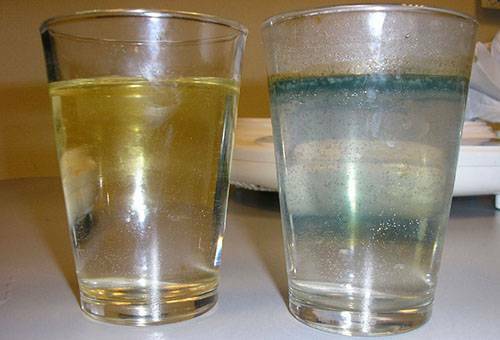
How to determine the concentration of iron in water?
In a centralized water supply system in the city, the reason for increasing iron is always steel water pipes. Simply put, rust from the pipeline mixes with water, but it does not dissolve. The easiest way to determine the presence of rust( trivalent iron) is to give water to stand in any transparent container. If after several hours at the bottom a rusty precipitate forms, it is time to take safety measures and to purify water from trivalent iron.
Board
A rusty coating on the washbasin, bathroom or toilet is a clear indication that the rust from the pipes gets into your faucet. With such "symptoms" you need to go from diagnosis to fixing the problem.
From artesian wells water enters into the house with iron dissolved in it( bivalent).Increasing its level can be determined visually - the water becomes slightly yellowish. But the color change does not always happen. In this case, a weak solution of potassium permanganate will help. If the pink solution is added to water with a high content of iron, its color will change to yellowish brown.
Colloidal iron may be present if the fence is made from a shallow borehole, where surface waters enter. In this case, the standing water will be unclear, the suspension of the molecules of such iron does not settle to the bottom. If a film forms on the water surface - iron bacteria are in the water.
If the tap water has the above characteristics or a metallic taste, you need to select a cleaning system. To do this with maximum efficiency, a sample of water must be taken to the laboratory. Having the results of the research on hand, it is possible to select the deironing system correctly.
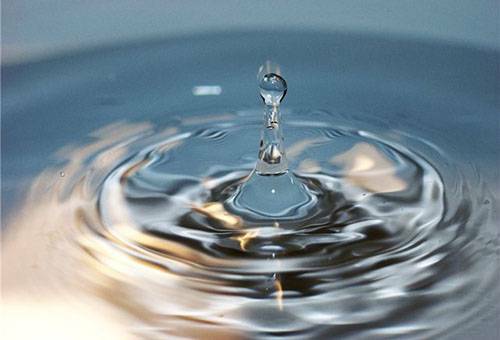
Methods for cleaning
There are two types of methods for removing iron and its compounds from water - reagent and reagent. If filters with reagents are used, it is necessary to monitor their replenishment.
The filtration can be performed in the following way:
- aeration;
- ion cleaning;
- membrane, including osmotic cleaning;
- ultrafiltration;
- sediment filtration;
- mechanical cleaning.
It should be noted that there is no universal method that cleans all kinds of contaminants. That is why it is so important to determine what type of pollution is present.
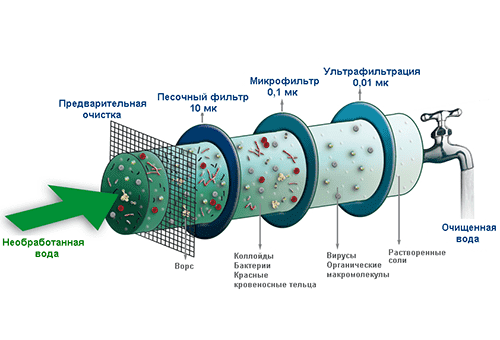
Mechanical cleaning
Mechanical filtration systems( mechanical cartridge filters) have proved themselves well. They are suitable if you need to clean water from large fractions of insoluble iron( rust).To remove oxides used propylene cartridges and cartridges with fine granular granules.
They are mainly used in apartments and houses with centralized water supply, since it is impossible to purify water from a well in this way. Rather, mechanical filters are used in cottages, but with preliminary oxidation( aeration) of metal compounds.
The method of mechanical cleaning with macro filters( the size of the delayed particles is more than 15 microns) is used for water purification. Cartridges with 5 μm cells are installed for fine filtration.
Board
Prefiltration or a coarse filter detains large fractions, making fine-mesh cartridges much longer.

Ion filtration
Water purification by ion exchange is a reagent method that allows selectively changing the ionic composition of water. If the task is to remove iron, then in the filters as ion exchangers, catalytic resins with various fractional additives are used. They replace metal ions with sodium ions.
The reagent environment loses its capabilities over time, but can be restored. For this use citric acid or common salt( solution).The advantage of this method is that deironing does not entail the precipitation of salts of stiffness and removes not only rust, but also dissolved in water metals, including manganese. One disadvantage is that the catalytic resins are only partially reduced by the salt solution, and after 2-3 years they completely exhaust their resource.
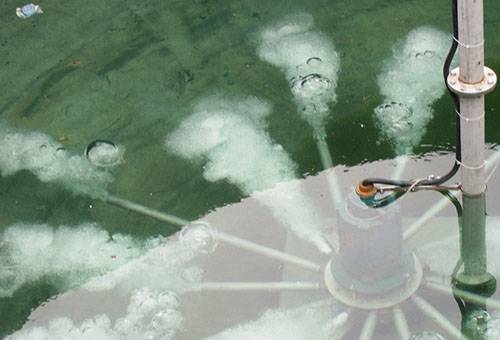
Aeration
In water supplied from an artesian well, there are various metal compounds, including bivalent iron in a dissolved state. Since it is impossible to purify water from a well qualitatively without the preliminary oxidation of ferrous iron, the method of aeration is used, that is, the saturation of water with oxygen. As a result, the metal passes from the dissolved state to insoluble oxide, and after that it can be removed with a mechanical or other filter.
Aeration can be produced both by pressure and non-pressure.
- With non-pressure aeration, water is supplied to the oxidation tank, in which spraying and strangulation occurs. Dushirovanie it is made by means of atomizers or an injector. Oxides accumulate at the bottom of the aeration tank, and it must be cleaned periodically - from two to five times a year, depending on the degree of water pollution.
- Pressure aeration is performed in a static mixer or aeration column. They are the contact chamber into which water flows( approximately two-thirds), and air is fed through the tube to the level of the middle of the column / mixer. Thus bubbles bubbling a saturated air mixture and oxidation of bivalent iron. In addition, in the column at the boundary between water and air, secondary( secondary) aeration takes place, which increases the quality of purification.
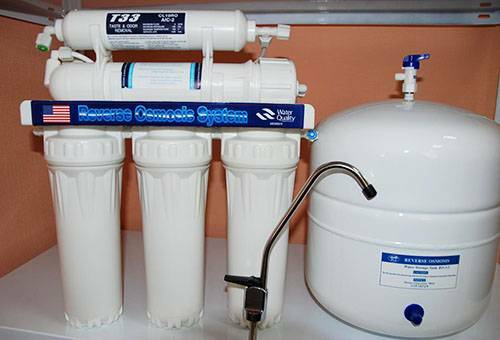
Reverse Osmosis
The reverse osmosis purification system is the most advanced fine filter with pre-cleaning. With the help of reverse osmosis membranes, there is a qualitative filtration of drinking water from all impurities. A prefilter built into the system delays insoluble metal particles with a fraction of more than 0.5 microns and inorganic iron dissolved in water.
The main stage of cleaning is carried out by a membrane with pores measuring 0.0001 microns, under the influence of a pressure difference. As a result, pure water molecules separate from water of increased density( saturated with organic compounds of iron and other pollutants), which merges into the drainage system. The drawback of the reverse-osmosis filter can be called only its low productivity. However, such a degree of purification is needed only for drinking water and water for cooking, and with this volume, reverse osmosis is easily handled.
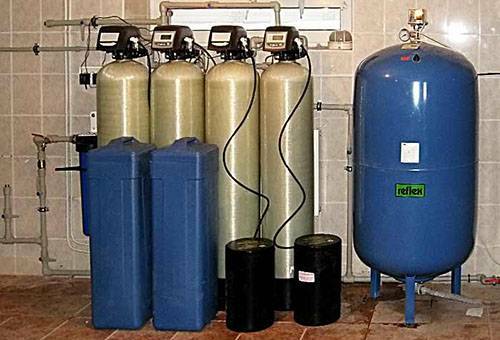
Backfill filter with backwash system
Filtration of water with backfill refers to sediment and reagent methods. It is necessary for water treatment of water from wells, when the aeration method is not suitable for technical reasons or is insufficient. As a filtration medium( backfill), the branded materials Birm, Manganese Greensand, MTM, Pyrolox are used. Backfilling reduces the time required for oxidation by hundreds of times.
Automatic cottage deferrilizer is arranged as follows.
- Filter housing - cylinder - filled with filter media.
- The machine is equipped with a timer and a flow meter. Its function is to change the direction of water at a specified time during filtration and regeneration.
- A water-lifting pipe passes through the entire backfill layer inside the cylinder.
- A flexible tubing is connected to a reagent container.
During the filtration cycle, water passes through the filling, lifts up the water pipe and exits the purification system. When the regeneration cycle comes, water is fed into the water-lifting tube from above. It loosens the layer of the filtering backfill and flushes the iron compounds settled there. After that, the machine performs a reagent treatment of the filter medium, which restores its chemical activity.
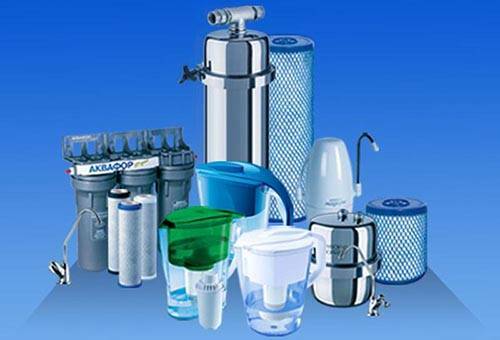
What to choose?
To properly select the filtration system, as mentioned above, you need to do a water analysis in the laboratory. It will be much cheaper than selecting a filter by trial and error, and it will also help to establish the optimal filtration system. The installation of filters also depends on the purpose for which water is needed.
Fine filters are superfluous if it is a question of preparation of water for household( washing, shower) or technical needs. But for drinking water, their availability is mandatory - depending on the results of laboratory tests.
We recommend that you read the article: what filter for water to choose for the house
